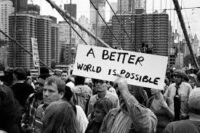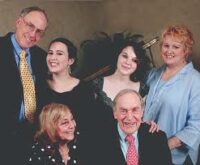Building a Movement–1
This will be the first of three blog posts on building a peacebuilding movement—or better yet—movements. I’ll write the first two before a group of about forty peacebuilders, political activists, and others meet in Washington to begin getting one started later this month. The third one will be a lengthier one and focus on what the group decided to do.
 The Premise
The Premise
So far, most peacebuilders and conflict resolution specialists have worked on the assumption that we should try to get others to join us in our efforts. And, we have made considerable progress in doing so in the 35 years since I first got involved in the Beyond War movement.
To cite but one example, the term win-win has entered everyday discourse. Thus, it is hardly surprising when ESPN commentators or sportswriters talk about a trade as being a win-win outcome for both teams.
The fact of the matter is, however, that we have not made much progress on two critical and related fronts,
- We have not had much of an impact on the way public policy and other key decisions are made in the United States. Quite the contrary. If anything, the American public is more divided and tensions are running higher than they have at any time since the height of the Vietnam war in the 1960s.
- When we have made progress in a given community or even on a given issue, we haven’t been able to take it to scale on a state-wide let alone a national level
So, the group will be taking a different tack. We will start with the assumption that we can have a greater impact by going to the places where people routinely take their conflicts today. Sometimes, they do go to conflict resolution specialists. More of than not, however, they go to their places of worship, schools, libraries, coaches, and others. Many of the people who work in those fields think the way we do, but they rarely think of themselves as being part of a unified movement for social change.
We will try to get something along those lines started.
Two Starting Points
This week, I had the pleasure of meeting with two people who can’t be at our workshop plus but will be involved as we go forward. One is someone I barely knew; the other is the daughter of one of my best friends from college and grad school whom I hadn’t seen in at least a decade.
Both had things to say that I’ll try to work into our proceedings. They are also worth sharing here.
Francine Madden
 I first met Francine Madden at the Alliance for Peacebuilding’s annual conference last fall when she talked about the need to treat people with respect—even when we profoundly disagree with them. The session had focused on some of the more divisive issues in American political life and reflected the liberal biases of most people in the room.
I first met Francine Madden at the Alliance for Peacebuilding’s annual conference last fall when she talked about the need to treat people with respect—even when we profoundly disagree with them. The session had focused on some of the more divisive issues in American political life and reflected the liberal biases of most people in the room.
Until Francine started talking about her work bringing together environmentalists, ranchers, and others around the question of wolves in the state of Washington. Like many other states, Washington is divided between mostly urban environmentalists who want to protect the wolves who have returned after decades of virtual extermination. Meanwhile, ranchers and others are convinced that the presence of wolves threatens their livelihood.
In most of the United States, these kinds of disputes feel a lot like World War III. Francine has been able to defuse some of the tensions and move the stakeholders toward solutions they can all live with and sometimes actually be happy with.
Madden’s team at the Center for Conservation Peacebuilding has enjoyed the most success in its work on the dispute over wolves in the state of Washington. In fact, the two halves of the state are a microcosm of the United States as a whole. The western half of the state is epitomized by Seattle and its tech-based boom and its liberal citizenry. The eastern half of the state is almost exactly the opposite.
Madden’s team did its homework, conducting hundreds of interviews and holding dozens of meetings with everyone involved in the dispute. As is almost always the case, they discovered that there is a cultural divide that makes the specific dispute over wolves all the harder to solve. So, Madden’s team found ways to bring the parties into the same room(s) and get to know each other as people as well as addressing the problems posed by the growing wolf population. They also helped the two sides realize that there was no magic solution that would make everybody happy, especially in the short run. Rather, she helped them see that they could take incremental steps that could both improve the existing situation and transform the way the two sides deal with each other, which could then be used in helping resolve other conflicts that are bound to arise in such a divided part of the country.
Abby Rapoport
Abby Rapoport is a journalist who does not see herself as a conflict resolution specialist at all. After years of reporting for progressive magazines in Texas, she has set off on her own with a slick new travel magazine, Stranger’s Guide, which is aimed at millennials. It might seem foolhardy to launch a print magazine that costs $15 an issue, but Abby just might make it—in part because Stranger’s Guide appeals to the tourist’s social conscience as well as his or her wanderlust.
 In fact, I only know about Stranger’s Guide because Abby’s grandfather had been one of my mentors and her father is one of my oldest friends. At our fiftieth college reunion, Ron mentioned that he thought I’d be interested in what she was up to and might be able to help her build interest in the magazine.
In fact, I only know about Stranger’s Guide because Abby’s grandfather had been one of my mentors and her father is one of my oldest friends. At our fiftieth college reunion, Ron mentioned that he thought I’d be interested in what she was up to and might be able to help her build interest in the magazine.
When we spoke, it became clear that Abby had a lot to offer for our work at the Alliance for Peacebuilding, too. So far, the three issues of Stranger’s Guide have dealt with three conflict zones where at least some of AfP’s members are active—the Caribbean, Moscow, and Mexico. The Caribbean issue, for example, take on topics our members should know about—the political history of the islands, the social situation in Jamaica and Haiti, the trans community in the Dominican Republican, and, of course, baseball.
As we talked, we realized that her mission and mine overlapped in more ways than we initially thought. To cite but one example, couldn’t she do an issue on how an interest in the dispute over wolves would alter the way a traveler would design a trip to the American northwest?
So, I invited Abby to our event l. If she can work out her schedule, she’ll attend her first peacebuilding event in nearly 20 years. The last one came when her entire family helped launch Search for Common Ground’s work in the United States when they all looked a good bit younger than they do in this picture taken shortly before her remarkable grandparents died.
The views and opinions expressed in this article are those of the author and do not necessarily reflect the official policy or position of the Alliance for Peacebuilding or its members.
Also published on Medium.
